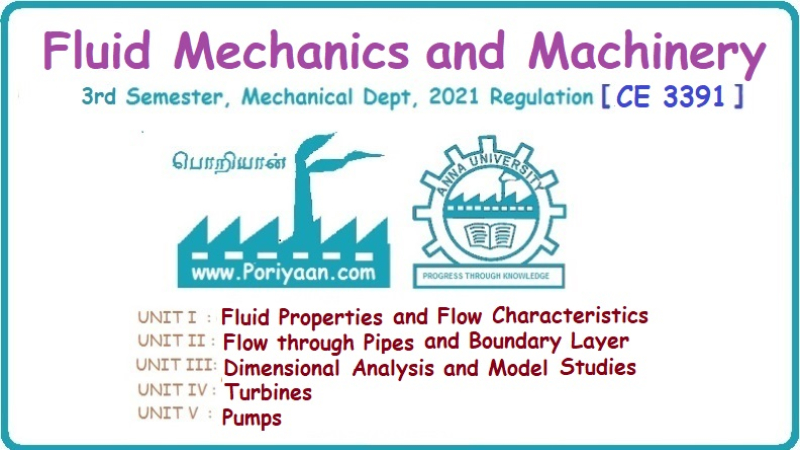Fluid Mechanics and Machinery: Unit 3: Dimensional Analysis and Model Studies
Buckingham's π- Theorem
Dimensional Analysis
1. Procedure to Solve Problems by Using Buckingham's π - Theorem 2. Method of Selecting Repeating Variables.
BUCKINGHAM'S π- THEOREM This method as formulated by Buckingham in 1915, states that if there are n variables (dependant and independent variables) in a physical phenomenon and that variables having m fundamental dimensions (M, L, T), then the variables are arranged into (n-m) dimensionless terms. Each term is called π - term. 1. Procedure to Solve Problems by Using Buckingham's π - Theorem Consider X1, X2, X3, X4, X5 are the variables involved in a physical problem. X1 be the dependant variables and X2, X3, X4, X5 are the independent variables. Step 1: Write the fundamental Equation ✓ Write the fundamental equation is expressed as X1 = ƒ (X1, X2, X3, X4, X5) ✓ The functional equation is must be equal to Zero. So the above equation can be written as f1 (X1, X2, X3, X4, X5) = 0 ...(i) Step 2: Findout the number of π - terms The functional equation has written in terms of number of dimensionless groups (oг) π- terms of in which number of π- terms equal to (n - m) n - Total number of variables (dependant and independant) m - Number of Fundamental dimensions (M, L, T) In above case n = 5, m = 3 Number of dimension less group (or) π terms = n – m = 5 – 3 = 2 Hence functional equation is written by. f (π1, π2) = 0 ...(ii) Step 3: Selecting Repeating variables Each π terms contains (m + 1) variables where 'm' is the number of fundamental dimension (M, L, T) and is also called repeating variables. So the number of repeating variables is three and it consists of first one is geometrical property, second one is flow property and last one is fluid property. In above case X2, X3, X4 are the repeating variables. Step 4: Write the all π-terms with arbitary powers. Each π-term is written with (m + 1) variables that consists of three repeating variables and one non - repeating variables. The repeating variables were written with arbitary powers. Step - 5: Find out values of arbitary powers (a1, b1, c1, a2, b2, c2 ...etc) Each π - term is solved by the principle of dimensional homogeneity and values of arbitary powers are obtained. Step - 6 Substituting the values of a, b, c in their corresponding π1, π2 terms. Step - 7 The value of π1, π2 are substituting in the functional equation. (i.e) Equation (ii). Step - 8 The required expression can be obtained by expressing any one of the π- terms as a function of others with constant ϕ. π1 = ϕ [π2] 2. Method of Selecting Repeating Variables. The number of repeating variables should be equal to fundamental dimensions m = 3 (M, L, T) ✓ As for as possible the dependant variables should not be selected as repeating variables. ✓ Repeating variables should be select such a way that one variable contain geometric property, second one having flow property another one having fluid property variables ✓ The repeating variables should not be dimensionless parameters such as co- efficient of discharge Cd, Efficiency η etc. ✓ Two variables should not have same dimensions in the selected repeating variables. ✓ The repeating variables together must have same number of fundamental dimensions. (i) Geometric property Length (l), Diameter (d), Height (h), Head (H)... etc (ii) Flow property Velocity (V), gravity (g), Rotational speed (N), Angular velocity (ω)... etc, (iii) Fluid property Density(ρ), viscosity (μ)...etc, The choice of repeating variables for most of fluid mechanics problems (i) d, V, ρ (ii) d, V, μ (iii) d, V, ρ (iv) L, V, μ (v) L, V, ρ (vi) H, g, ρ (vii) d, ω, ρ a, b, c are the arbitary powers and X1 & X5 are non- repeating variables.
a, b, c are the arbitary powers and X1 & X5 are non- repeating variables.
Fluid Mechanics and Machinery: Unit 3: Dimensional Analysis and Model Studies : Tag: : Dimensional Analysis - Buckingham's π- Theorem
Related Topics
Related Subjects
Fluid Mechanics and Machinery
CE3391 3rd semester Mechanical Dept | 2021 Regulation | 3rd Semester Mechanical Dept 2021 Regulation
